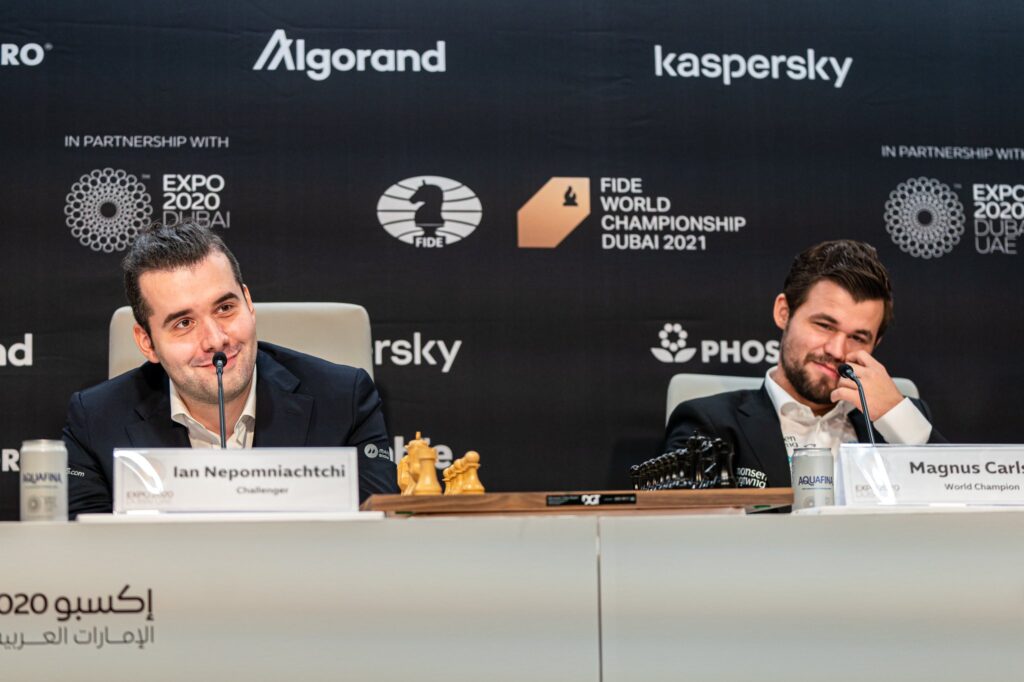Magnus Carlsen and Ian Nepomniachtchi are under attack for producing a string of draws in the world championship. But their critics misunderstand the essence of the game
John Foley
The drawish nature of the games in the world championship is receiving adverse comment as usual. Apart from in the chess community, there does not seem to be much public interest in the match, in spite of many newspapers designating correspondents for the event. The trouble is that people don’t like draws. If presented as a sport, the public likes to hear about winning and losing, not a streak of draws.
Magnus Carlsen has played 48 games in the world championship finals, including matches against Anand (India) 2013/14, Karjakin (Russia) 2016, Caruana (USA/Italy) 2018, and the three games of the present match. Of these, 39 were drawn or 81%. By contrast, for all games in regular over-the-board competitions, Magnus has a drawing rate of 44% (per chessgames.com). So why are world championship games more drawish and should we worry?

The most straightforward explanation is that a title match is quite different from a normal tournament. The stakes are much higher and the nature of the contest is different. Both sides have teams of analysts who are working the silicon engine to wrench the minutest fraction of an advantage from the opening. The players are briefed on the latest developments and, provided their memories hold up, it is extremely rare for someone to completely surprise their opponent.
There is also the mutual familiarity of the players. They are well matched and have been jousting with each other since 2002, when Nepo won the under-12 world championship and Magnus was second. They know each other’s styles inside out. They know their strengths and weaknesses, and know what to prepare. Nepo has a lifetime plus score in classical games of 4-1 with 11 draws (69% draws). They have played more than 80 games together in all forms of chess.
On paper, there is not much to choose between the players. The betting gives Magnus the advantage, but, as the match progresses, the odds become more even because a single game can make all the difference. The match also gets more tense, so there is a greater chance of a mistake, which balances the odds.
The prize pot is €2 million, of which the winner gets 60%. So in effect, the money at stake is €400,000 (20% of €2 million). Both players are guaranteed €800,000, even if all games are drawn. There is no incentive for either player to go all-or-nothing on some risky opening. They are both comfortable whatever the outcome.
The real problem is that chess has been oversold as a spectator sport. We can be grateful to The Queen’s Gambit for stimulating extraordinary interest in the game. Chess can be played in stylish surroundings by smartly dressed, beautiful young people. However, chess has been raised on to a pedestal in Dubai, where it is exposed to the full glare of the world’s media. Journalists are looking for a story to tell the people back home.
We cannot blame the players for not playing in the 19th-century romantic style. Nor can we blame them for playing high-level, error-free, technical chess. These two players are the product of the computer engine age and will have exhaustively analysed virtually all the main openings. They don’t blunder.
It was different in the past. In 1972, Bobby Fischer was fighting the cold war against Boris Spassky. In 1983/84 Garry Kasparov was fighting the faltering Soviet system. The new generation is fighting a battle we have yet to describe. Maybe the underlying story is about which strand of artificial intelligence is going to dominate. The Red Queen evolutionary battle between, say, Stockfish and Alpha Zero is being played out by teams of computer scientists feeding ideas to the diligent seconds.
Some commentators have suggested speeding up the play – maybe one hour each for the game. This artificially enhanced excitement should be avoided. At least with slowplay time controls, the quality of the moves is uniformly high. There is no point in choosing a time control to generate more errors. I want games that are strategic masterpieces rather than resolved through tactical oversights; protein rather than sugar.
The players can never give the world what it wants, at least not as represented by the media. The public wants results, excitement, drama, a circus. In truth, chess is an inner game, a game of the soul and the mind, a striving towards perfection. If a player feels good about their game, their cognitive and emotional struggle, the ebb and flow of optimism and pessimism, and maintaining the will to win, then they have done their job. If they produce a game for the anthologies, then we should all regard that as a bonus. Chess is not for spectators and, truth be told, it is not even a sport.
Stop the press conferences. Let them play.
